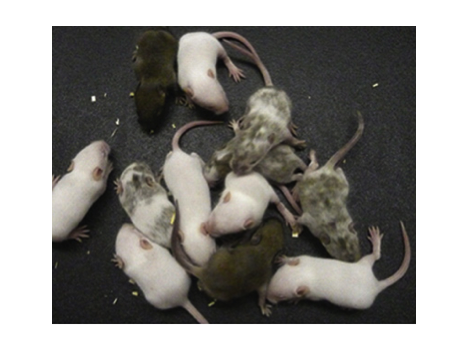Life After CRISPR – Steps to Take After Creating a New Mutant Mouse
Whether you’re developing a novel inhibitor or determining whether a gene variant is a disease-driver, you might need a mouse model that doesn’t exist yet. CRISPR technology allows you to generate new mutant mice quickly and precisely.
Using the classic CRISPR approach in mouse embryos, single or multiple guide RNAs direct the Cas9 protein to clip DNA at a desired genomic site. Cellular polymerases then repair the cut DNA in one of several ways to create frameshift mutations or small deletions. If donor DNA is also supplied, specific point mutations, loxP sites, tags, or fluorescent markers can be incorporated at the repair site.
After the CRISPR editing is complete, additional steps are required to generate usable mice, including raising the mouse pups and confirming with genotyping or sequencing that they carry the desired mutation. Here’s what to do next, after confirming that the live founder mice have the right mutation:
Breed…
The first step after creating a CRISPR edited mouse is to mate the founders to an inbred mouse strain to eliminate mosaics and off-target effects.
Depending on what stage of embryonic development Cas9 cut the DNA, not every cell in the fully-developed founder mouse may carry the desired mutation, resulting in a mouse that is somatically mosaic. To figure out if your CRISPR founder can pass the mutation onto its offspring, you’ll need to mate it to a wild-type mouse, ideally from the same inbred background in which you made the mutation. Any pups from this cross that carry the mutation, received it through the founder’s germline, and carry it in all of its cells. These mice are denoted “N1.”

Additionally, because guide RNAs occasionally produce off-target mutations, mating CRISPR founders to inbred mice will introduce “clean” DNA into your strain. This allows you begin to breed away from any unintended off-target mutations.
…and Breed Some More
- Expand the colony. Once you have a few clean N1 mice, increase the colony size for further analysis and characterization.
- Generate cohorts of experimental and control mice. Because you bred your founders to a wild-type mouse, your N1 mice will be heterozygous for the mutation. Decide whether the mouse is useful as a heterozygote or should be bred to homozygosity. Additional breeding to other mouse strains may be necessary to answer your question; for example, if you introduced a cre-conditional (“floxed”) allele, you’ll need to breed your CRISPR-generated mouse to a Cre strain to generate your desired knockout.
- A sizable mouse colony or experimental cohorts can be generated quickly by using a combination of traditional breeding and specialized reproductive techniques like in vitro fertilization (see Step 4, here).
Save the Mice for Later
Always cryopreserve unique mouse models by freezing down sperm or embryos. After taking the time and expense to make your strain, don’t risk losing it to a natural or facility disaster, breeding error, or genetic drift! Investing nominal resources to preserve some of your N1 mice or some version thereafter will ensure that your model with the original, germline transmissible mutation and phenotype will always be recoverable.
Characterize and Confirm the Effect
Did the CRISPR engineered mutation do what you were hoping it would do? If you were generating a tumor model, define when, where, and what kind of tumors arise. If you were making a mutant protein, try to detect it and determine whether phenotypic changes occurred in the appropriate tissues or in the animal’s behavior. Especially if you are planning to develop novel therapeutics on this model, you’ll need to know what to expect phenotypically and whether your model mimics the human condition. This will help you properly plan when to start dosing your mice, provide baseline data, and attempt to determine human relevance.
Start Dosing
With the model complete and the mutation properly characterized, you are ready to dose. Some considerations for efficacy testing and generating a dose-response relationship include route, frequency, and length of drug administration. How will you monitor whether your compound had the intended effect? What other experimental readouts could be informative? Involve your expert veterinary staff and Animal Care and Use Committee early and frequently as you navigate this space, as they will be best able promote humane animal use practices.
Let JAX Simplify and Streamline the Logistics
Investigators at JAX have been studying mouse genetics since the early 1900's and creating hundreds of CRISPR-edited mice since 2013 for both internal and external researchers. If you develop your CRISPR model at JAX, our project scientists can develop a plan to create (Model Generation Services), breed (Breeding and Rederivation Services), save (Cryopreservation Service), and test (In Vivo Pharmacology Efficacy Testing Services) your model, all at The Jackson Laboratory.